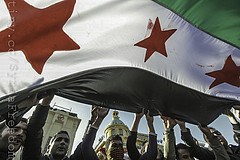
Even the most zealous ideologues have been challenged approaching Damascus. Thrown from their horse, they have been left dazed and partially sighted, forced to re-examine their norms.
Damascus has presented such a challenge once again in recent months. This time, it is the new norm in international relations known as R2P—the responsibility to protect—that has been temporarily unseated. It is a simple formula. This important new norm contends that it is the international community’s responsibility to protect civilians when a state fails in its responsibility to do so.
R2P has made swift progress in the international community since its adoption (in a watered-down form) at the United Nations Summit in 2005, gaining acceptance at the same time as the rise in indictments by the International Criminal Court. Together, this combination offers hopes of real progress in setting limits to crimes against humanity, genocide and war crimes.
But they are not yet everybody’s norm. The Syrian government’s brutal and indiscriminate attack on its own civilian population in response to pro-democracy demonstrations seems an easy call for the swift application of R2P. The UN Security Council might well be expected to agree on firm measures that would prevent further atrocities, or go further to intervene militarily if prevention does not work.
But it can’t. Alas, R2P is not the only norm in international relations. The current situation in Syria is strong evidence of a more ancient and enduring norm from imperial and Cold War days: when a strong repressive state has one or two very powerful allies it can easily resist the wider will of international society and public morality. As is well reported, Syria has seemingly unwavering Russian backing and China has no desire to see international military intervention into the Middle East again. Indeed, if truth be told, nor do most other states, even the ones most vocally condemning Syria.
What this shows is that in some places, like Sierra Leone and Libya, R2P is do-able. In places like Darfur and Syria it is not. Why? Places with successful R2P application tend to have very small populations, with regimes bereft of a major ally and where popular backing for international action is nearly unanimous. A non-military R2P approach can also work at times. In Kenya in 2007-2008, Kofi Annan worked to create a negotiated solution and prevent a protracted civil war. But in this case, most major powers (and particularly the USA) put real pressure on their Kenyan ally. In Syria, even the deft but highly leveraged ‘Annan method’ is failing. The Syrian government has no incentive to abide by it, nor is the plan leveraged enough by major powers.
Finding another solution
So, what does this mean for the protection of civilians in Syria? If R2P lies dazed and confused on the road to Damascus, what will protect civilians today and tomorrow? With no international intervention, Syrian civilians on all sides of the conflict will be thrown back on the usual options in most wars – their own initiative, luck, local military protection and humanitarian action.
Many civilians have already used their initiative to flee the country or to become displaced in safer parts of Syria. Hundreds of thousands are now living with host families, a tribute to Syrian hospitality. All civilians will be struggling for survival by learning the main patterns of military action and hiding from them as best they can. Many will be selling assets to buy food and essential supplies at ever-higher prices. Unemployment is rising dramatically and most people will soon be struggling more against impoverishment than armed attack.
Civilians in government-controlled zones, meanwhile, will receive military protection from government forces if there are no demonstrations. But increasingly they are at risk from indiscriminate bombings by an increasingly militant opposition, jihadist interlopers or government troops pretending to be both. If and when opposition controlled enclaves develop, then civilians may receive more systematic military protection from opposition armed forces.
Challenges to a humanitarian response
The formal international system of humanitarian action is struggling to operate on a large scale. United Nations agencies and the Red Cross are on the ground and building up their operations. But the Syrian government is deeply suspicious of international agencies and is determined to limit the presence of international NGOs like Medecins sans Frontieres, Oxfam, Care, Save the Children and the International Organisation of the Red Cross, who one would normally see operating en masse at this point in a non-international armed conflict. Unfortunately, another growing norm in international relations—shaped by experiences in Darfur, Myanmar, Sri Lanka and Rwanda, where NGOs have been expelled or kept firmly in check—encourages Syria to hold out against international civil society input, which Damascus regards as a western fifth column at worst, an unruly rabble at best.

Because of this the Assad government is requiring all humanitarian action to be registered and channelled through the Syrian Arab Red Crescent (SARC). This is a vindication of the Red Cross movement’s determination to have national societies in every country but it also puts the Syrian Red Crescent under intense operational and political pressure. Their need to remain impartial, neutral and independent is vital if they are to be accepted by all sides in the conflict. All signs suggest they are doing this well but the Assad government’s authoritarian determination to control the organisation as the single channel of aid is very strong.
UN agencies have little room for manoeuvre at present and no room for strong advocacy statements. The head of UNICEF was recently expelled for going public with details of child deaths. The government is also intent on clamping down and controlling local Syrian NGOs to prevent them becoming opposition solidarity organisations.
In such a confined operational context, international humanitarian strategy will have to develop an innovative combination of direct and indirect support to civilians. UN agencies and government donors will need to build up the Syrian Red Crescent while maintaining its impartiality and professionalism. This means scaling-up its operational capacity fast without bursting the organization or creating an aid monolith to be co-opted and controlled by the state.
But the scale of suffering looks set to outstrip a single channel response. Humanitarian strategy will need to develop vital market-based interventions that get cash, loans, food and essential health and education supplies into the local markets where small informal aid groups, host-families and displaced people can make the most of them beyond excessive government interference.
Taking steps
Alongside the UN and the SARC, the International Committee of the Red Cross is the other major pillar of international humanitarian action that will be central to a humanitarian strategy in Syria. In line with its international mandate, it has the authority and ability to operate with all parties in this conflict and is well placed to do so. The organization will play an essential role to assist and protect civilians across conflict lines, and will also function as a wise advisor and capacity-builder of SARC.
A time may come when a more assertive form of the R2P norm may be possible, or when international NGOs are able to engage more fully in government or opposition areas. But the priority now is to support the United Nations, the Syrian Red Crescent and the ICRC to make the most of the options at their disposal.
In some ways, having such a small group of agencies leading a response will avoid the coordination chaos that is so often a feature of more crowded humanitarian emergencies. This simpler humanitarian structure may be the silver lining in the cloud that currently hangs over Syrian civilians. Let’s hope it enables clear focus and vital humanitarian innovations.
Dr Hugo Slim is a Senior Research Fellow at the Oxford Institute for Ethics, Law and Armed Conflict and the author of Killing Civilians: Method, Madness and Morality in War.





No Comment